Marvel at bizarre fish in the ocean
Until now humans have only discovered 5% of mysteries in the vast ocean. The strange animals that surprised us are the best proof of the mysteries of the sea. Eel wolves, sheep heads, red-lip bats, . are three of the most bizarre shaped fish that humans have ever known to live in the ocean.
Red lip bat fish
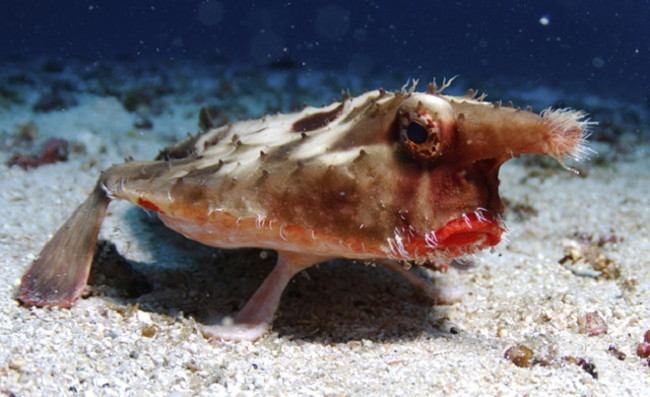
Photos: Wikipedia
The red lip bats have the scientific name of Ogcocephalus darwini living in the Galapagos Islands of Ecuador on Pacific waters, according to Encyclopedia of Life. This fish possesses "sensitive" lips as it is used to attract mates or prey.
We can only find this fish at a depth of 30 m under the sea. Red lip bat fish can reach a length of 25 cm. In particular, they have a structure of pectoral and dorsal fins that look like limbs, so they have a rather odd swimming style but are an effective means for this fish to go under the sea.
Fish long chimaera nose
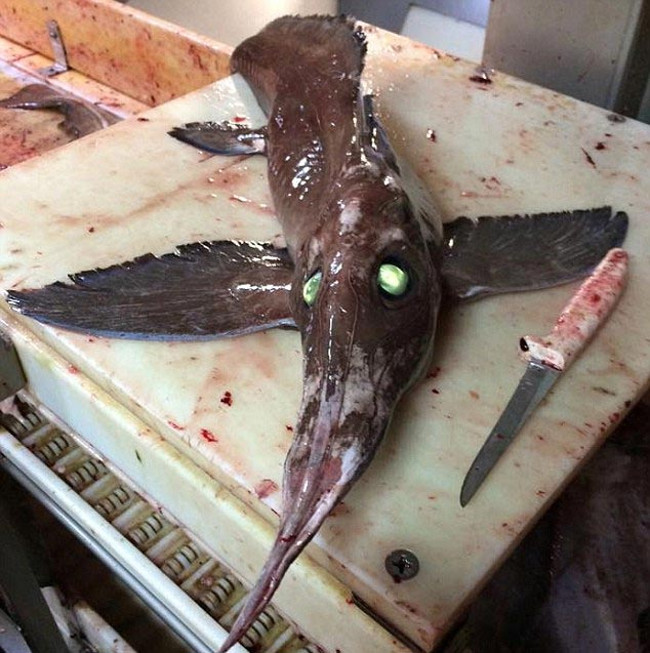
Photo: Scott Tanner
In March 2016, Scott Tanner fishermen off the coast of Nova Scotia in eastern Canada discovered a strange fish with a long, nearly body-like nose, glowing green protruding eyes and pairs of fins like wings.
It is a fish of the Chimaera species, scientific name is Harriotta raleighana , living in deep waters. H. raleighana. According to scientists they have relatives with sharks, rays and stingrays and are one of the oldest fish on earth. They often crawl the seabed at a depth of about 380-2,600 m, find prey by induction of charge on the nose.
They use the long nose to push the body in the water and smash it like flapping wings to move.
California lamb head fish
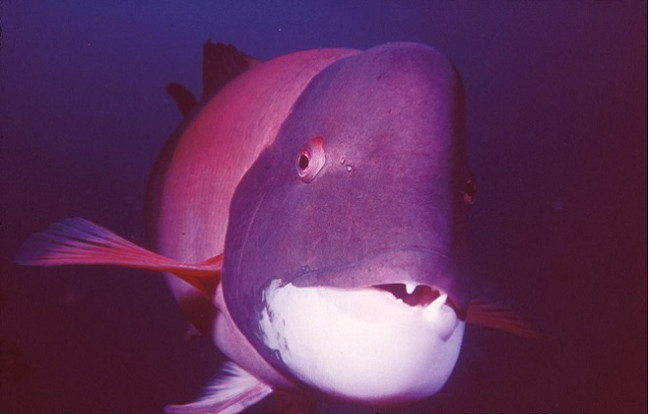
Photo: Channel Islands Marine Reserve, USA
Semicossyphus pulcher live in coastal rocks and kelp forests from the Channel Islands to the Bay of Monterry, USA.
When born, all individuals of sheep head are children. By about 8 years some will turn into males and stay the same for nearly 50 years of their life.
Fish with long nose injection
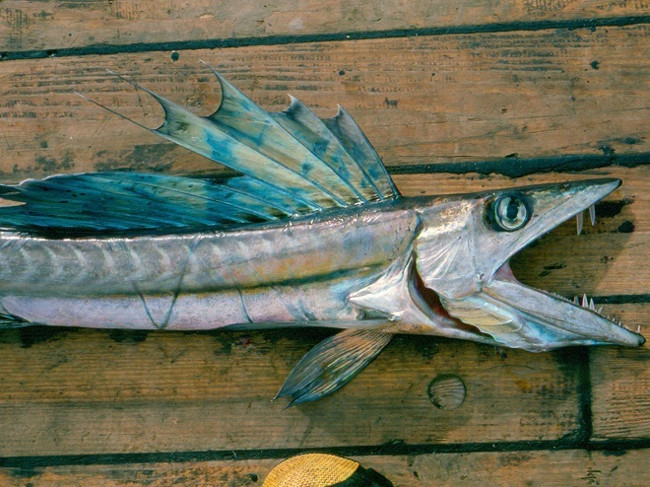
Photo: NOAA
The tongue of a long nose (Alepisaurus ferox) is a carnivorous assassin known for its large fangs, large dorsal fins shaped like a sail. In the transition period before adulthood, the long-nosed tongue has both male and female genitalia. But scientists have not determined whether they maintain this duality when entering adulthood.
The long nose fish can reach a length of 2 m and is a killer fish that specializes in hunting at night. Their favorite prey is shellfish, squid and smaller fish that even eat their own flesh.
Lion fish
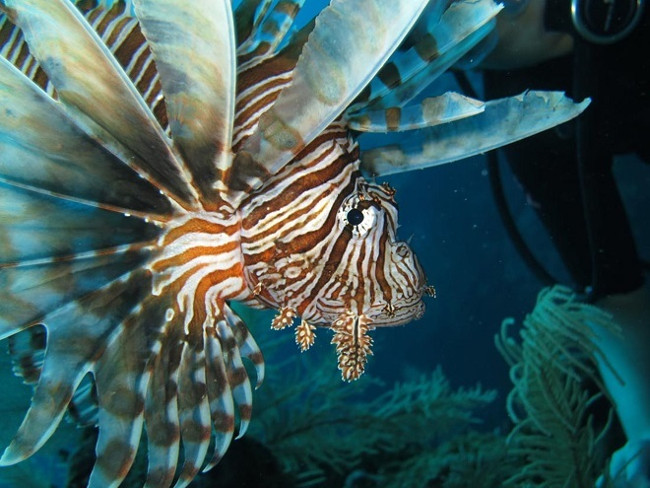
Photo: Walter Hackerott
The lion fish is also known as the common lionfish with a length of 30-38 cm and the body is full of poisonous spines to help them avoid the predation of all enemies. They reproduce very quickly, a female reaches her reproductive age at the age of one and can lay between 30,000 and 40,000 eggs a day.
Without enemies, spawning quickly makes the number of lion fish rapidly increase. According to scientists, the most effective way to control the number of fishes is human catching.
We can find this fish in tropical South Pacific waters.
Parrot fish
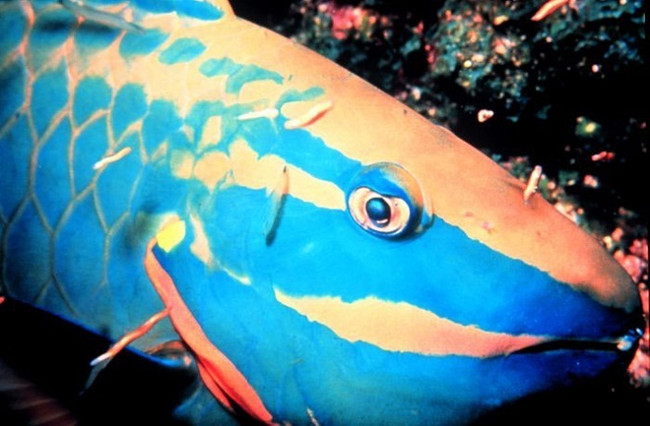
Photo: NOAA
This is a colorful fish with a beak-like mouth and strong teeth used to crush corals, eat algae inside. Therefore, most of the sand in the distribution of parrot fish is part of undigested coral that they emit out.
Sex, color and pattern on parrot fish body changes many times in their life cycle. Especially when sleeping, this fish will encase itself in a cocoon made of mucus secreted from a part of the head to hide the odor and avoid night predators.
Ocean sun fish
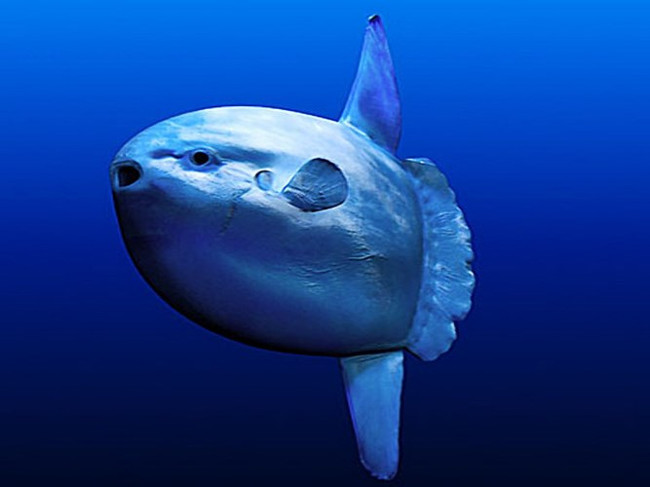
Photo: National Marine Reserve, Farallones Bay, USA
Giant ocean fish, also known as mola mola, is the world's largest bony fish because the adult male can reach an average length of 3.5 m, weighs 1.7 tons and 4 fin length. , 5 m. Sunfish have oval or nearly round bodies usually float to the surface to receive heat from sunlight. When this fish floats on the surface, we mistakenly think they are sharks because of their large dorsal fin.
Although the body is large, the Sun fish has a very small mouth. Because there are no teeth, they use their tongue to crush jellyfish, small crustaceans and plankton.
Scalloped fish
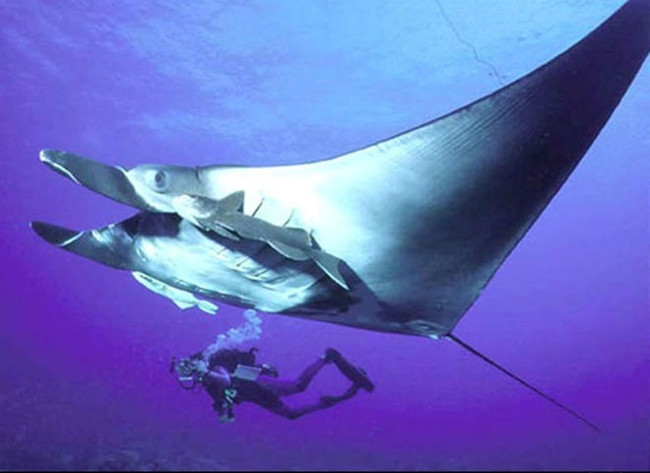
Photo: NOAA
Scallop fish include coral reef fish (Manta Alfredi) and giant sea bass (Manta birostris) that live in tropical, subtropical and temperate waters in the Indian Ocean, Atlantic and Pacific Ocean.
Scalloped fish is a large, flat fish with their fins length up to 9 m. Their food is plankton. Currently both species of crutches are listed as threatened in the Red Book of the International Union for Conservation of Nature.
Electric stingray
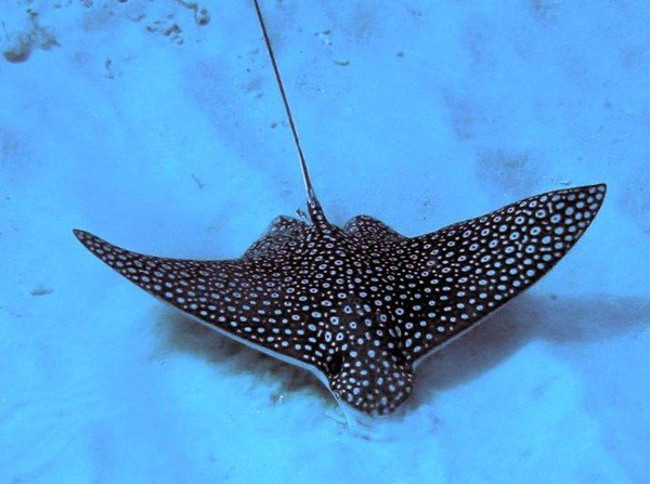
Photo: Daniel Gotshall
Electric stingray has a gray body and black dots. Stingray voltage depends on their size, small rays produce less than 10 volts and larger individuals are capable of generating up to 220 volts. Electric stingrays often catch prey with electric shocks. In addition, they use electrical sensitivity to detect predators, find partners and communicate with each other.
Moray eel
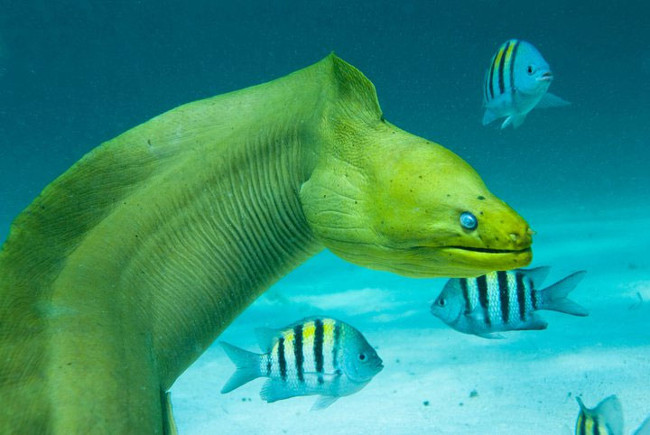
Photos: Wikipedia
The moray eel or eel sea consists of about 200 species of the Muraenidae family. They live mainly in the sea, some species are distributed in freshwater or brackish water. This fish possesses strong, sharp teeth like glass with a length of up to several centimeters.
Because the head is quite narrow, moray eels cannot swallow large prey, so they have another tooth inside their mouth to grab food and bring it to the stomach.
The food of moray eels is fish, crustaceans and mollusks.
Four-eyed butterfly fish
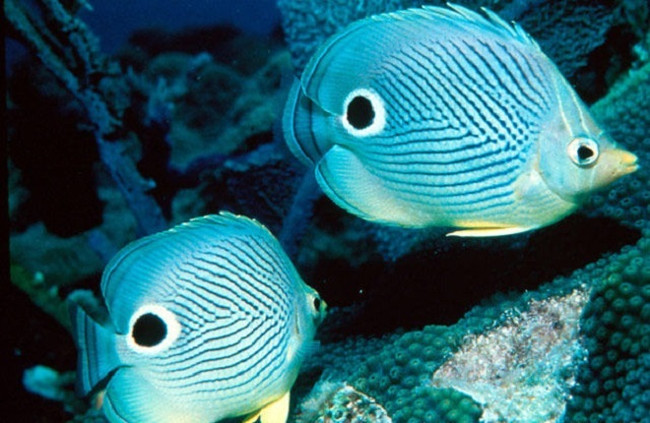
Photo: Chris Huss / Florida Islands National Marine Islands Marine Conservation Park, USA
This species belongs to Chaetodon capistratus family, residing in coral reefs in Florida Keys, USA. When two butterfly fishes are in a mouth-to-mouth pose, they will form butterfly wings, which is the reason for this fish's name.
Butterfly fishes are paired throughout the life cycle, so are often observed as a pair of swimmers side by side.
Puffer fish
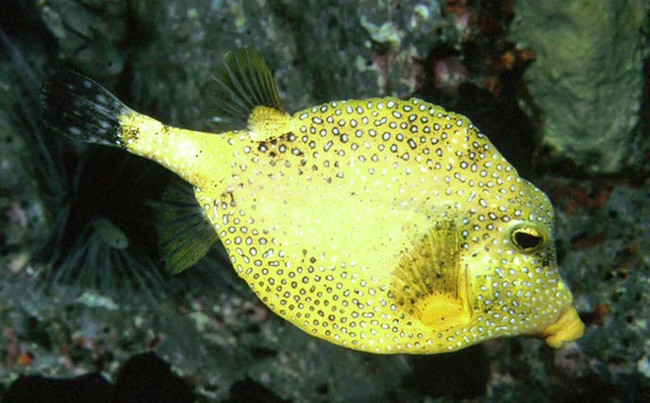
Photos: Frank and Joyce Burek
The puffer fish (lactophrys triqueter) is usually only white and black. But Dr. Christy Pattengill-Semmens, director of the Marine Conservation Center in Sandiego, USA, recorded an unusual yellow individual and named the yellow moonfish puffer.
Eel wolf
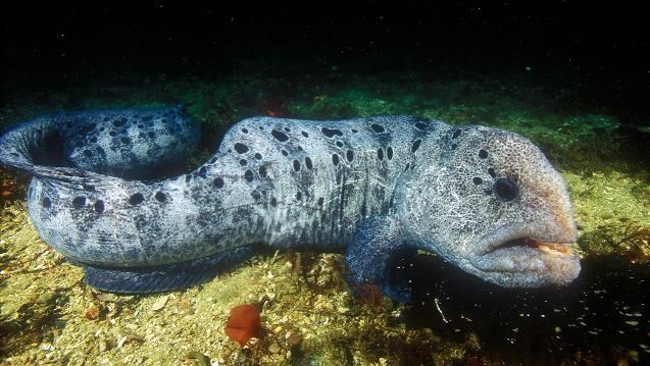
Photo: Montereybayaquarium.org
Eel wolves are actually a fish belonging to the Anarhichadidae family. The distinguishing feature of them with eels is the pectoral fins behind the head.
The young eel wolves are quite prominent in the water with impressive bright yellow and purple bodies. As they grow, these colors fade, giving way to brown and gray. Adults often have black spots on their heads and different bodies in each individual.
They can grow to 203 cm, 18.6 kg and are found in the northern Pacific, from the waters of Japan and the Aleutian Islands to northern California.
Eel wolves are quite voracious. Their food is crabs, sea urchins, slugs, abalone, mussels and fish. Thanks to their powerful jaws, they can crush hard foods.
You should read it
- 10 species of land predatory fish in the natural world
- Strangely, fish can live on land for five years without dying
- Simple tips make it easy to identify fresh, delicious fish
- Scary aquatic monsters specialize in 'drilling' shark meat from within
- After the river flows into the sea, where did the freshwater fish go?
- The most expensive fish in the world, the highest record is over 71 billion a tuna
- Like humans, fish also have arthritis?
- Robot fish helps us experience the close-up of the ocean world
May be interested
- Close-up of the deepest living fish in the ocean ever recorded by camera
 this is the deepest living fish on the seabed ever recorded. university of western australia deep-sea scientist, professor alan jamieson, said that if this record is broken, it is likely that the depth will only increase by a few meters.
this is the deepest living fish on the seabed ever recorded. university of western australia deep-sea scientist, professor alan jamieson, said that if this record is broken, it is likely that the depth will only increase by a few meters. - Close-up of fish walking on the seabed surprised many people
 a strange orange-like creature that looks like a fish moving on the seabed is like walking making the viewer stunned.
a strange orange-like creature that looks like a fish moving on the seabed is like walking making the viewer stunned. - Catching a strange long-body shark like a snake, possessing up to 300 teeth and dating back to prehistoric times
 researchers from portugal's marine and atmospheric research institute were stunned to 'encounter' a strange shark that existed from prehistoric times in the deep waters of the coastal ocean. algarve (portugal).
researchers from portugal's marine and atmospheric research institute were stunned to 'encounter' a strange shark that existed from prehistoric times in the deep waters of the coastal ocean. algarve (portugal). - Captain Marvel wallpaper set of high resolution for computers
 this is a captain marvel background with many different resolutions, suitable for all computer screens
this is a captain marvel background with many different resolutions, suitable for all computer screens - Marvel's Midnight Suns - a super product with extreme graphics, promising to cause storms in early 2022
 instead of focusing on the glitz of superheroes, marvel's midnight suns will lead players to explore the dark side of the marvel's universe.
instead of focusing on the glitz of superheroes, marvel's midnight suns will lead players to explore the dark side of the marvel's universe. - Marvel Future Revolution - Download Marvel Future Revolution
 marvel future revolution is an action role-playing game with superheroes in the marvel world on the mobile platform.
marvel future revolution is an action role-playing game with superheroes in the marvel world on the mobile platform. - How to download Marvel Super War for iOS and Android
 how to download marvel super war for ios and android in this article will help you to experience this exciting moba game soon even though it has not been officially launched in vietnam.
how to download marvel super war for ios and android in this article will help you to experience this exciting moba game soon even though it has not been officially launched in vietnam. - Summary of the latest Marvel Rivals codes
 this article will gather all the working marvel rivals codes for you. they give you skins, packs or other free gifts to customize your character.
this article will gather all the working marvel rivals codes for you. they give you skins, packs or other free gifts to customize your character. - Deep-water fish use hydrothermal vents to hatch eggs
 research groups at the ocean, darwin fund and galapagos national park management board discovered that some larvae hatch their eggs in deep hydrothermal vents, an unprecedented behavior. observed in marine animals.
research groups at the ocean, darwin fund and galapagos national park management board discovered that some larvae hatch their eggs in deep hydrothermal vents, an unprecedented behavior. observed in marine animals. - Good fish oil, Uses and How to drink
 fish oil has long been known for its health effects such as eye tonic, good for the nervous system, memory enhancement, concentration, good for the heart, relieving stress, anxiety, good for skin ... so good fish oil, how to drink omega 3 fish oil effectively?
fish oil has long been known for its health effects such as eye tonic, good for the nervous system, memory enhancement, concentration, good for the heart, relieving stress, anxiety, good for skin ... so good fish oil, how to drink omega 3 fish oil effectively?










 Discover new snake species in Con Dao
Discover new snake species in Con Dao The mysterious witch forest in England
The mysterious witch forest in England Fear of poisonous plants that corrode humans
Fear of poisonous plants that corrode humans The truth about the 'she' elephants in the elephant world
The truth about the 'she' elephants in the elephant world Strange creatures hide deep in the ocean floor
Strange creatures hide deep in the ocean floor Hurricane No. 3 is approaching level 14 in Vietnam
Hurricane No. 3 is approaching level 14 in Vietnam